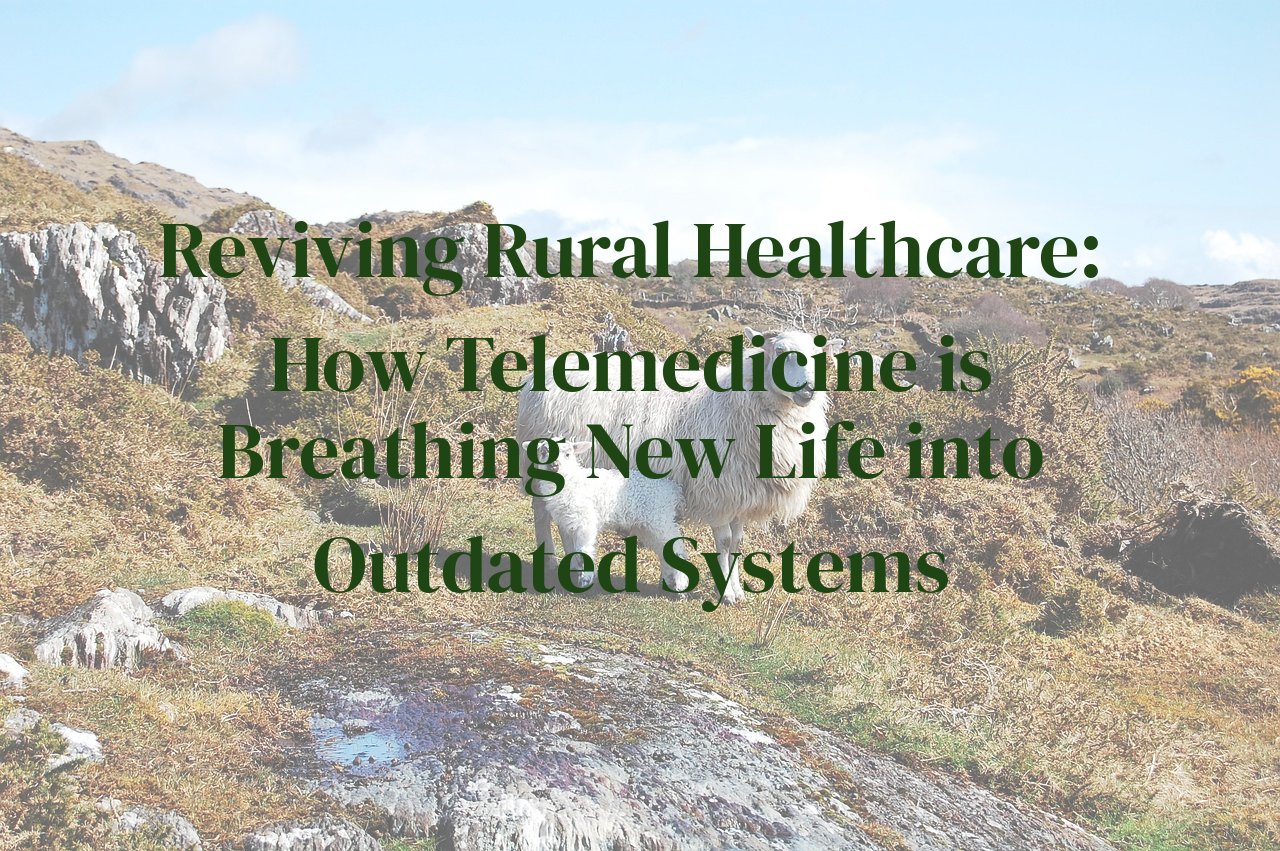
Diving headfirst into the evolving world of rural healthcare, this post uncovers how telemedicine serves as a revolutionary tool, revitalizing traditional healthcare systems in remote areas. ‘Reviving Rural Healthcare: How Telemedicine is Breathing New Life into Outdated Systems’ explores key mechanisms and benefits of telemedicine, particularly tailored for rural communities.
Readers will learn how telemedicine can significantly improve healthcare access, enhance patient outcomes, reduce costs, and ultimately transform the healthcare experience for underserved populations. Through engaging insights and practical advice, discover how you can navigate and harness this modern healthcare frontier to bolster community well-being.
Table of Contents
The Current Landscape: Challenges in Rural Healthcare
The current state of rural healthcare is a complex mosaic of deeply entrenched challenges that have persisted for decades. As someone who grew up in a small rural town, I have seen these issues firsthand. The first and perhaps most glaring issue is the severe shortage of healthcare professionals. Many rural areas struggle to attract and retain doctors, nurses, and specialized medical staff. Without these key players, delivering comprehensive care becomes a monumental task.
Another significant challenge is the geographical barriers that separate patients from healthcare facilities. In an urban area, a trip to the doctor might mean a quick bus ride or even a brisk walk. However, in rural settings, patients often live miles away from the nearest clinic. Many of these individuals lack reliable transportation, turning what should be a simple doctor’s visit into an insurmountable obstacle.
Moreover, rural hospitals and clinics often operate with outdated equipment and limited resources. Financial constraints lead to subpar facilities that cannot adequately serve their communities. This lack of infrastructure not only hinders the diagnosis and treatment of common ailments but also makes specialized care almost impossible. In times of illness or injury, the community has to bear the brunt of inadequate healthcare services.
Compounding these issues is the high rate of chronic diseases in rural populations. Conditions like diabetes, hypertension, and respiratory diseases are disproportionately prevalent. These chronic conditions require ongoing medical supervision, which is hard to come by in areas where healthcare services are fragmented at best. This creates a vicious cycle where the lack of access to adequate healthcare exacerbates health problems, which in turn puts even more strain on the limited healthcare resources.
Financial burdens are another hurdle. Limited insurance coverage and higher rates of poverty in rural areas make healthcare unaffordable for many. The financial strain often deters people from seeking medical attention until it is absolutely necessary, at which point conditions have often worsened. Additionally, the lack of healthcare coverage means that preventive services, which could alleviate long-term costs and complications, are often skipped altogether.
Furthermore, mental health services are notably lacking in rural communities. Issues such as depression, anxiety, and substance abuse often go untreated due to the stigma surrounding mental health and the absence of trained professionals. My community has seen the tragic consequences of this deficiency, with preventable mental health crises leading to devastating outcomes.
The digital divide also plays a critical role in perpetuating healthcare disparities. Limited broadband access in rural areas makes the adoption of digital health solutions, including telemedicine, a significant challenge. Even when telehealth services are available, unreliable internet connections can make virtual consultations frustrating and ineffective. This gap in technology further isolates rural communities from potential healthcare innovations that could bridge existing gaps.
What is Telemedicine? Breaking Down Technology’s Role
When it comes to reimagining how we deliver healthcare in rural areas, telemedicine is nothing short of a game-changer. At its core, telemedicine leverages digital communication tools to provide clinical healthcare services from a distance, tearing down geographical barriers that once seemed insurmountable. This beautifully transformative approach uses various technologies, each playing a distinctive role in bringing medical care to remote corners where traditional systems often fall short.
Firstly, video conferencing platforms serve as the digital clinic rooms. They facilitate real-time face-to-face consultations between healthcare providers and patients, allowing for the diagnosis and treatment of many conditions. This is akin to having a doctor pop up in your living room, bringing the expertise of a major medical facility to you, no matter your locale. From my own experience, I’ve seen the relief and gratitude in patients’ faces as they connect with specialists they would otherwise never meet in person.
Next in line is remote patient monitoring (RPM). RPM utilizes connected devices like glucose meters, blood pressure cuffs, and even heart rate monitors to keep tabs on a patient’s vital signs from afar. For people managing chronic conditions, this is a lifeline. Imagine elderly patients with limited mobility receiving daily checks without the hassle of traveling. The data collected is transmitted securely to healthcare providers, who can then adjust treatment plans in real-time. This constant flow of information is a crucial component of personalized care in rural settings.
Another indispensable tool is mobile health applications, or mHealth apps. These apps offer a plethora of services ranging from medication reminders and mental health support to fitness tracking and educational resources. They essentially put healthcare in the palm of the user’s hand. During a trial I participated in, feedback from rural users indicated a notable increase in medication adherence and health literacy. This speaks volumes about the potential of mHealth in destigmatizing and demystifying healthcare.
Cloud-based platforms also come into play by providing a secure and accessible place for storing electronic health records (EHR). The convenience of having patient records readily available for any healthcare provider involved in a patient’s care cannot be overstated. Imagine a rural resident suffering from allergies who visits both a local clinic and a distant specialist; having an integrated platform ensures continuity of care and avoids potentially dangerous medical errors.
Telemedicine also leverages AI-driven diagnostic tools, which assist in identifying diseases and conditions based on complex algorithms and vast databases of patient information. These systems enhance the diagnostic accuracy and provide a second opinion, especially beneficial for rural healthcare centers that may not have specialists on hand. I’ve personally witnessed AI suggesting early interventions that have literally been life-saving.
Lastly, real-time collaboration tools enable seamless communication between different healthcare providers. Specialists, general practitioners, nurses, and even pharmacists can easily share knowledge and insights, ensuring the patient receives the best possible care. During a telehealth initiative I was part of, the ability for a rural nurse to instantly consult with an urban cardiologist brought a level of care that was previously unthinkable in those communities.
In sum, telemedicine is not just about technology; it’s about rehumanizing medicine by bringing it back to where it’s most needed. It’s a poetic blend of innovation and empathy, offering a lifeline to those who have long been forgotten by outdated healthcare systems. This heartening transformation is why I firmly believe telemedicine is not a fleeting trend but a cornerstone of modern healthcare.
Success Stories: Telemedicine Transformations in Rural Areas
The rise of telemedicine has unveiled some truly inspiring transformations in rural healthcare settings. It is nothing short of miraculous how this technology has redefined healthcare accessibility and quality in isolated communities.
Take, for instance, the story of Clairfield, Tennessee. This small town, nestled in the Appalachian Mountains, had long been plagued by both a lack of specialist care and geographical isolation. Introducing telemedicine was like a breath of fresh air. Specialist consultations, once a grueling journey away, are now just a click away. A local clinic empowered by telehealth services has made it possible for residents to get care from top-tier cardiologists without leaving town.
In North Dakota, telemedicine has become a lifeline during harsh winters. Residents in remote areas used to risk it all by traveling treacherous roads for appointments. Now, with virtual consultations, healthcare continues uninterrupted through the snowy months. Virtual mental health support has been exceptionally beneficial, providing timely assistance to individuals wrestling with Seasonal Affective Disorder (SAD) during those long, dark winters.
One of the standout stories comes from the Navajo Nation. This vast area has grappled with inadequate healthcare infrastructure for decades. With telemedicine, the tide is turning. Patients can connect with specialized doctors at urban hospitals without the need for hours-long trips. Telehealth initiatives have specifically helped in managing chronic illnesses like diabetes, providing regular check-ins and dietary consultations that were previously out of reach.
On the maternal health front, telemedicine has been transformative in rural parts of Africa. In remote villages, pregnant women now have access to prenatal care via mobile health clinics equipped with telemedicine capabilities. The results? Reduced maternal mortality rates and healthier pregnancies, thanks to timely and consistent medical advice.
These stories echo a common theme: the true power of telemedicine lies in its ability to bridge gaps, both geographical and social. It gives small-town residents access to top-notch healthcare, often equalizing the playing field with their urban counterparts. With every success story, another layer gets peeled back, revealing the enormous potential of technology to revolutionize rural healthcare systems.
Having closely followed these transformations, I feel a blend of awe and optimism. It is a testament to human ingenuity and the relentless spirit to bring healthcare where it is needed most. Indeed, telemedicine is teaching an old system new tricks, and the results speak for themselves.
Practical Implementation: Starting or Expanding Telemedicine Services
Starting or expanding telemedicine services in rural areas might seem daunting, but with the right approach, it is entirely achievable. Drawing from personal experience, here are some steps and considerations that can guide you through the process.
Assess the Need: Before launching a telemedicine program, conduct a thorough needs assessment. This involves surveys, interviews with local healthcare providers, and community feedback. Understanding the specific healthcare needs, barriers to access, and technological capabilities of the community will help tailor the service effectively.
Infrastructure Development: Reliable internet and appropriate hardware are crucial. This might mean collaborating with local government or private entities to enhance broadband access. Additionally, investing in telemedicine carts, diagnostic tools, and secure communication platforms ensures a smooth experience for both healthcare providers and patients.
Training and Support: Introducing telemedicine involves a learning curve. Providing comprehensive training for healthcare staff and ongoing technical support is essential. This includes not just the use of technology but also adopting new workflows and maintaining patient confidentiality in a digital environment. From my experience, engaging a dedicated IT support team greatly enhances the process.
Regulatory Compliance: Compliance with healthcare regulations such as HIPAA in the US is mandatory. Ensuring the telemedicine platform meets all legal requirements regarding patient data security and privacy cannot be overstated. Collaborating with legal experts to navigate these regulations can prevent future complications.
Patient Education and Engagement: Educating patients about telemedicine is critical. Create educational materials, hold community sessions, and offer one-on-one assistance to familiarize patients with the new system. Highlight the benefits, such as reduced travel time and access to specialists, to foster acceptance and utilization.
Integrate with Existing Services: Telemedicine should complement, not replace, current healthcare services. Work with existing healthcare providers to create a seamless integration. This might include shared record systems and coordinated care plans, ensuring a holistic approach to patient health.
Monitor and Adapt: Finally, continuous monitoring and adaptation are key. Collect feedback from both providers and patients to identify areas for improvement. Regularly review the program’s effectiveness and be willing to make necessary adjustments. Using real-time data analytics can provide valuable insights for ongoing refinement.
Embarking on the journey of telemedicine in rural areas is by no means simple, yet the rewards—improved healthcare access, better patient outcomes, and more efficient service delivery—are substantial. By following these steps, you can breathe new life into rural healthcare systems, as I’ve seen firsthand in numerous successful implementations.
Future Trends: Innovations to Watch in Rural Telehealth
The future of rural telehealth is brimming with exciting possibilities, reflecting a blend of advanced technology and creative problem-solving. One trend that stands out is the integration of Artificial Intelligence (AI) and Machine Learning (ML). These sophisticated tools are already revolutionizing healthcare by providing predictive analytics, personalized medicine, and automated diagnostics. In rural areas, AI could help identify patterns in patient data that human eyes might miss, leading to earlier interventions and more effective treatments.
Another compelling innovation is the advent of remote patient monitoring (RPM) devices. These gadgets, ranging from smartwatches to specialized medical equipment, allow healthcare providers to keep tabs on patients’ vital signs in real-time. This not only reduces the need for frequent in-person visits but also ensures timely medical responses to any anomalies detected. The effectiveness of RPM is particularly pronounced in managing chronic diseases like diabetes and hypertension, which are prevalent in rural settings.
Diving deeper, we see the potential of Virtual Reality (VR) and Augmented Reality (AR) in telemedicine. Imagine a rural doctor performing a complex surgery under the guidance of a specialist located miles away, connected through AR glasses. VR is also making strides in mental health treatment by offering immersive therapy sessions for conditions such as PTSD and anxiety. These technologies hold promise for bringing specialized care to even the most remote locations.
Also, worth noting is the expansion of telepharmacy services. In rural areas where pharmacy access is limited, telepharmacy can bridge the gap by providing consultations, medication management, and even home delivery of prescriptions. This approach not only enhances patient convenience but also ensures better adherence to prescribed treatments.
Moreover, innovations in broadband technology, like the deployment of 5G networks, are set to transform rural telehealth. High-speed internet is the backbone of telemedicine, facilitating seamless video consultations and data sharing. The introduction of 5G will dramatically improve connectivity issues that have long plagued rural areas, ensuring that telehealth services are accessible to all.
In my years of exploring telemedicine, the most heartwarming development has been the rise of community health worker (CHW) programs empowered by technology. CHWs, equipped with mobile health apps, can offer valuable services ranging from health education to disease screening in rural communities. These programs not only create jobs but also build trust within the community, fostering a more effective healthcare network.
Finally, blockchain technology is emerging as a game-changer for telehealth security and patient data management. Blockchain’s decentralized nature ensures that patient records are not only secure but also easily accessible to authorized healthcare providers, simplifying the sharing of crucial medical information across various platforms.
It’s truly inspiring to witness how the merging of healthcare and technology is breaking down barriers and paving the way for more equitable healthcare solutions in rural areas. The innovations on the horizon promise to bring not just improved access but also higher quality and more personalized care to those who need it the most.
Conclusion
By integrating telemedicine into rural healthcare systems, patients and providers alike can overcome substantial barriers, making quality care more accessible and efficient. As we continue to embrace technological advancements, the potential for telemedicine to bridge gaps and foster healthier communities cannot be overstated.
Remember, whether you’re a healthcare provider or a concerned community member, your active participation in this movement can help shape a brighter, healthier future for rural areas everywhere. Stay informed, stay engaged, and let’s champion the cause of telemedicine together.



